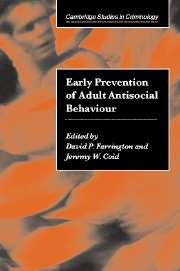Book contents
- Frontmatter
- Contents
- List of figures
- List of tables
- List of contributors
- Preface
- 1 Advancing knowledge about the early prevention of adult antisocial behaviour
- 2 Formulating strategies for the primary prevention of adult antisocial behaviour: “High risk” or ‘population’ strategies?
- 3 Risk factors for adult antisocial personality
- 4 Preventing the intergenerational continuity of antisocial behaviour: Implications of partner violence
- 5 Protective factors and resilience
- 6 Prevention during pregnancy, infancy and the preschool years
- 7 Prevention through family and parenting programmes
- 8 Prevention in the school years
- 9 Prevention of antisocial behaviour in females
- 10 Economic costs and benefits of primary prevention of delinquency and later offending: A review of the research
- 11 Conclusions and the way forward
- Index
- References
6 - Prevention during pregnancy, infancy and the preschool years
Published online by Cambridge University Press: 22 September 2009
- Frontmatter
- Contents
- List of figures
- List of tables
- List of contributors
- Preface
- 1 Advancing knowledge about the early prevention of adult antisocial behaviour
- 2 Formulating strategies for the primary prevention of adult antisocial behaviour: “High risk” or ‘population’ strategies?
- 3 Risk factors for adult antisocial personality
- 4 Preventing the intergenerational continuity of antisocial behaviour: Implications of partner violence
- 5 Protective factors and resilience
- 6 Prevention during pregnancy, infancy and the preschool years
- 7 Prevention through family and parenting programmes
- 8 Prevention in the school years
- 9 Prevention of antisocial behaviour in females
- 10 Economic costs and benefits of primary prevention of delinquency and later offending: A review of the research
- 11 Conclusions and the way forward
- Index
- References
Summary
Much attention has been paid to the increase in delinquent behaviour from pre-adolescence to the middle of adolescence, followed by its decrease from late adolescence to early adulthood (Elliott, 1994; Farrington, 1986). Using official statistics, the director of the Brussels Observatory in the early nineteenth century, Quetelet (1833), described this phenomenon and concluded that ‘This fatal propensity seems to develop in proportion to the intensity of physical strength and passions in man’. More recently, Ellis and Coontz (1990) concluded that this crime bell curve could be explained by the increase of testosterone levels during puberty.
Surprisingly little attention has been paid to the link between the ‘strength of passions’ during early childhood and later delinquency. There is evidence that the most disruptive toddlers are at highest risk of becoming the most deviant adolescents and adults (Caspi, Moffitt, Newman and Silva, 1996; Stattin and Klackenberg-Larsson, 1993; White, Moffitt, Earls, Robins and Silva, 1990). Furthermore, there is evidence that the peak frequency of physical aggression during an individual's life is generally attained at around 24 months after birth (see Figure 6.1, and Tremblay et al., 1996; Tremblay, Mâsse, Pagani and Vitaro, 1996) and not during mid- or late adolescence. Observational studies of the frequency of physical aggression between toddlers count the number of physical aggressions within a fifteen or thirty minute period (e.g., Hay and Ross, 1982), while studies during adolescence generally count the frequency of aggressions over a twelve-month period.
- Type
- Chapter
- Information
- Early Prevention of Adult Antisocial Behaviour , pp. 205 - 242Publisher: Cambridge University PressPrint publication year: 2003
References
- 14
- Cited by



